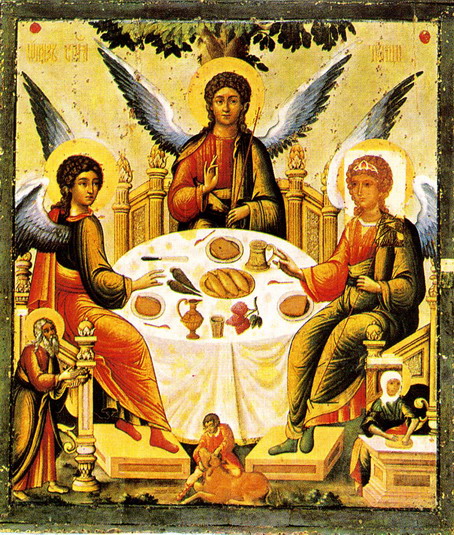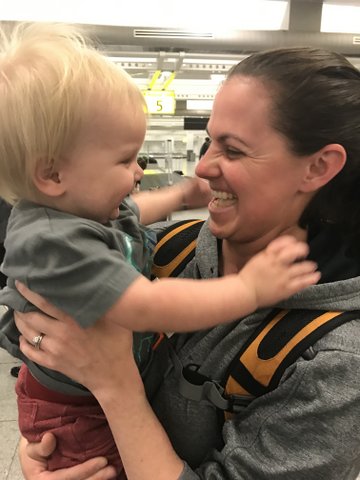
The sick and the suffering are a powerful icon of Christ

By Tikhon Filatiev, via Wikimedia Commons
This is part of a series about our 2017 pilgrimage to Lourdes with the Order of Malta American Association. You may want to start with the first post, or see all the posts about our family’s Lourdes pilgrimage(s) in reverse chronological order.
An icon is a highly stylized and symbolic representation of Jesus, a saint, or another holy person. As Linette Martin, an iconographer, explains in this article: “The pictures are not there just to be looked at as though the worshipers were in an art museum; they are designed to be doors between this world and another world, between people and the Incarnate God, his Mother, or his friends, the saints.” Icons are gazed upon and contemplated, the way one might sit before the Blessed Sacrament in Adoration, quietly, openly, expectantly.
Everywhere we went in Lourdes, this contemplative, loving gaze was turned upon Oscar, our family, and other Malades and caregivers. The effect of this gaze, on both the bestower and the object, was transformative. In fact, I think it’s key to understanding the power of everything that goes on in Lourdes.
***
Continuing our backward march through the week, let’s turn to Saturday. That afternoon, we attended a Eucharistic procession, Adoration, and Benediction in the Domain, which is the central area of Lourdes that contains the Grotto, the baths, and all the churches. In a Eucharistic procession, the Body of Christ is displayed in a gold monstrance and carried high at the front of a procession of clergy, followed by worshipers. Hymns are sung and prayers are recited. Several people told us that of all the healing miracles that occur at Lourdes, many more of them occur during the Eucharistic procession than during visits to the baths.

The monstrance, and the Rosary Basilica in the background. (Photo: Michelle Babyak)
As with any other organized activity in Lourdes, it was a hurry-up-and-wait affair. The American Association processed hurriedly from our hotels through the narrow, crowded streets to the assembly point, then waited nearly an hour for the larger Eucharistic procession to begin. While we waited, Ryan, our charioteer, asked to hold Oscar. (The charioteer’s job is to pull and maneuver the blue voiture every single time we needed to go anywhere as a group; he had certainly earned a few baby cuddles!) Ryan has young children at home, whom he was obviously missing, so he had taken to Oscar immediately, bouncing him in his arms at every opportunity, referring to him as “Baby Jesus.” I responded by nicknaming Ryan St. Christopher, in reference to the saint who, according to legend, carried Baby Jesus across a raging river.
Hefting Oscar into his arms, Ryan stepped aside to the shade of a nearby tree. Oscar had been unusually alert that day, and watched him soberly. They proceeded to have a prolonged, one-sided chat. Each one’s eyes were firmly fixed on the other’s. Even without words, Oscar seemed to be communicating volumes to Ryan. Thank you for being here. I trust you. It was as if the world around them had disappeared; they had eyes only for each other.

Ryan and Oscar deep in thoughtful conversation. Eventually, that hat ended up on the other head. (Photo: Michelle Babyak)
The procession commenced, and Oscar was redeposited on my lap. The day could not have been more triumphantly beautiful. Every pre-travel communication we received strongly suggested we pack for cold, rainy weather. But it was 70 degrees and sunny the entire week, except for a brief cold front and shower very late Friday night. Saturday was a mild, perfect spring day.

Processing to the plaza, with the Grotto in the background. (Photo: Michelle Babyak… just go ahead and assume any gorgeous photos were taken by Michelle, our official pilgrimage photographer.)
My main impressions of the service itself were of utter peace, contentment, community. The blue sky shimmered, the birds twittered in the trees overhead, the air was festooned with incense and chanting voices. Everywhere, people smiled, or prayed, or wept with wide open hearts. The Spirit was present, and working overtime.
***
Later that evening, we showed up at the cocktail hour, hosted by the Order of Malta every night before dinner. As soon as we walked in, a priest we had not yet met cornered us to tell us how much he appreciated our presence, and how moved he had been watching Todd and I with Oscar throughout the trip. I felt embarrassed but touched, as if I were being given credit for something I hadn’t actually done. When he continued, saying that he had included our story in his parish bulletin for the following weekend, the feelings only intensified. Even before we departed, people were thanking us for our presence on the pilgrimage and calling us a blessing. But I knew what a gift we had been handed, and I was dead certain they had it backward.
What I didn’t realize in that moment, of course, was that there was no forward or backward. This was exactly the same two-way door that icons open for us. Oscar’s pilgrimage was not just to spread joy, as I mentioned in my last post, but to serve his fellow pilgrims as a living image of Christ suffering on the cross. Only an image, only a shadow, but what a powerful one.
This was finally hammered home about five minutes later. We stopped to chat with some new friends of ours, who had shown up late to the procession. As a result, they ended up sitting way down in the front with the pilgrims from Bohemia. Kathy noted how much more demonstrative and affectionate the Bohemians were, describing the group as just one big love fest. She pulled out her camera and said, “I have to show you this picture. It will explain what I mean. Well, maybe you had to be there, but I think it is the most incredible picture I’ve taken all week.”
On the screen of her digital camera, she pulled up a little thumbnail, an image that so simply captured what it means to love another human being that I gasped out loud. It depicted a young Dame of Malta, in her twenties, wearing the trademark white veil. Her hand and chin rested on the knee of “her” Malade, who was seated in her wheelchair with her back to the camera.
The Dame’s eyes were turned up to her Malade’s face, a gaze overflowing with perfect, peaceful Love. It was a love in perfect contemplation of its desired object. It was the gaze of the beloved.
Such a gaze requires two: the lover and the beloved. The servant and the sufferer. The Christian and Christ.

Oscar and his new friend Katie saying a happy goodbye at JFK
The exchange of love between God the Father and God the Son is the engine that eternally creates God the Holy Spirit. And anywhere else in the universe where that exchange of love is taking place, the Holy Spirit is brought forth anew. Anywhere that someone recognizes Christ within another, and stops to look, love is reborn.
Oscar was Christ to others by offering himself as a willing receptacle to that unabashed, foolishly generous love. They, in turn, served as Christ to him with their hands and their feet, feeding, clothing, bathing, carrying him. But they also served as Christ to him with their eyes, just by the simple act of gazing at him—and at every Malade present—with the same adoring love that we turn upon Christ Himself.
Another mother in our group told about how her son had blossomed under this gaze, all week long. Instead of being seen as the sum of his diagnoses and problems, he was just… seen. Seen as a child of God, seen with the eyes of Christ. By the end of the week, being seen had healed his heart. That example, of others simply gazing with love upon her child, had made it more possible for her to see him in this way, too. And, if my own experience is any indication, seeing even one person in this way makes it more possible to see everyone.
Maria also noted something a priest once said to her: “Do not go out and buy icons. Go downtown and look at Christ in the faces of the poor.” For this very reason, during the Orthodox Liturgy it is not only icons that are censed by the deacon or priest but each person standing in the church.
From Praying with Icons, by Jim Forest
This is not idolatry. This is profound recognition of the fact that Christ resides in all of us. We are all icons, all windows to heaven. But this is doubly true for the sick and disabled, whose suffering is a visible reminder of Christ’s sacrifice for us. In some special places like Lourdes, where the mundane details of our everyday lives are stripped away, such a bare encounter with living icons can blossom into that all-powerful love that sets souls, and then the whole world, on fire.
Want more of the story? Read my other Lourdes 2017 posts here:
